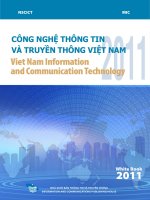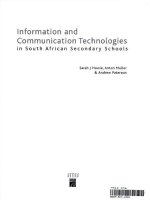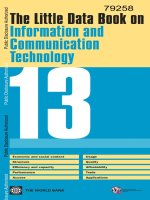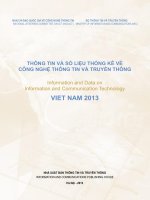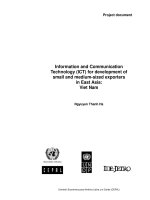Adoption of information and communication technology in public administration in oromia region
Bạn đang xem bản rút gọn của tài liệu. Xem và tải ngay bản đầy đủ của tài liệu tại đây (1.39 MB, 104 trang )
ADDIS ABABA UNIVERSITY
COLLEGE OF NATURAL AND COMPUTATIONAL
SCIENCES
SCHOOL OF INFORMATION SCIENCE
ADOPTION OF INFORMATION AND COMMUNICATION
TECHNOLOGY IN PUBLIC ADMINISTRATION IN OROMIA REGION:
THE CASE OF BEREH AND SENDAFA WOREDAS
BY
GIRMA ASEFA
JUNE, 2017
ADDIS ABABA, ETHIOPIA
ADDIS ABABA UNIVERSITY
COLLEGE OF NATURAL AND COMPUTATIONAL SCIENCES
SCHOOL OF INFORMATION SCIENCE
ADOPTION OF INFORMATION AND COMMUNICATION
TECHNOLOGY IN PUBLIC ADMINISTRATION IN OROMIA REGION:
THE CASE OF BEREH AND SENDAFA WOREDAS
A THESIS SUBMITTED TO THE SCHOOL OF GRADUATE STUDIES OF
ADDIS ABABA UNIVERSITY IN PARTIAL FULFILLMENT FOR THE
REQUIREMENTS FOR THE DEGREE OF MASTER OF SCIENCE IN
INFORMATION SCIENCE.
BY: GIRMA ASEFA
ADVISOR: LEMMA LESSA (PhD)
JUNE, 2017
ADDIS ABABA, ETHIOPIA
I
ADDIS ABABA UNIVERSITY
COLLEGE OF NATURAL AND COMPUTATIONAL SCIENCES
SCHOOL OF INFORMATION SCIENCE
ADOPTION OF INFORMATION AND COMMUNICATION
TECHNOLOGY IN THE PUBLIC ADMINISTRATION IN OROMIA
REGION: THE CASE OF BEREH AND SENDAFA WOREDAS
BY
GIRMA ASEFA
Name and signature of Members of the Examining Board
Name
Title
Signature
Date
Lemma Lessa (PhD)
Advisor
____________
___________
_________________
Examiner
____________
___________
_________________
Examiner
____________
___________
II
Declaration
This thesis has not previously been accepted in substance for any degree and is not being
concurrently submitted in candidature for any degree in any university.
This thesis is the result of my own investigations, except where otherwise stated. Other
sources are acknowledged by citations giving explicit references. A list of references is
appended.
Signature: ________________________
Girma Asefa
This thesis has been submitted for examination with my approval as university advisor.
Advisor‟s Signature: ________________________
Lemma Lessa (PhD)
III
DEDICATION
TO MY FATHER!
IV
Acknowledgments
First and foremost, my special thanks and heartfelt gratitude go to my advisor, Dr. Lemma Lessa
for his unreserved and invaluable guidance and support he has provided me from the
beginning to the end of the study, without which the completion of this work would have
been unthinkable.
My special thanks also go to my friend Dr.Bekan Eshetu for his endless support throughout
the process of my work.
I am also greatly appreciative to managers and ICT officers of Bereh and Sendafa Woredas
public administrations for the support they extended in the collection of relevant data in
their organizations.
I am also indebted to my parents for their courage and motivation they have provided me and
for sacrificing their precious time which I should have spent with them.
I would also like to thank all my classmates for the wonderful time we have spent together,
both in and outside the class room. God bless you all.
Girma Asefa
`
June, 2017
Addis Ababa, Ethiopia.
V
Abstract
Information Communication Technology (ICT) has become a significant tool to facilitate
human activity that has made contributing to the countries’ on economy and social welfare.
As extant literature reveal, the application of ICTs in the public administrations is basically
affected by the organizations context, technological context and environmental context
factors. Purpose of this study was to identify the challenges and contextual factors that drive
information and communication technology adoption in Bereh and Sendafa Woredas public
administrations.
To achieve objective a qualitative and quantitative approaches were conducted with a survey
that focused on ICT uses, its challenges and contextual factor that drive ICT in the public
administrations. The quantitative survey study was conducted on 230 respondents on both
Woredas and the qualitative key informant interview.
The data from both sources were combined and analyzed to get a view of the current
situation. The findings show that the public administrations are mainly hindered by a group
of challenges related to strategy design on ICT tools challenges for instances infrastructural,
standard Internet connectivity design issues and the forces that drive the ICT adoption also
ICT awareness creation among the top managers. Possible actions for management
intervention are also forwarded based on the key findings.
VI
Table of Contents
Acknowledgments ............................................................................................... V
Abstract ...............................................................................................................VI
Table of Contents.............................................................................................. VII
List of tables .......................................................................................................XI
List of figures.................................................................................................... XII
List of Acronym............................................................................................... XIII
CHAPTER ONE ................................................................................................... 1
INTRODUCTION ................................................................................................ 1
1.1. Background of the study ............................................................................ 1
1.2 .Statement of the problem ........................................................................... 3
1.3. Basic Research Questions .......................................................................... 5
1.4. Objectives of the study ............................................................................... 5
1.4.1. General objective ................................................................................. 5
1.4.2. Specific Objectives............................................................................... 5
1.5. Significance of the Research ...................................................................... 5
1.6. Scope of the Study...................................................................................... 6
1.7. Definition of Significant Terms ................................................................. 6
1.8. Organization of the Study .......................................................................... 7
CHAPTER TWO .................................................................................................. 8
LITERATURE REVIEW ..................................................................................... 8
2.1. Introduction ................................................................................................... 8
VII
2.2. Oromia Regions state ................................................................................. 8
2.3. Description of the Study Area .................................................................. 10
2.4. Public Administrations ............................................................................. 11
2.5. Adoption ................................................................................................ 11
2.5.1. Process of Adoption ........................................................................... 13
2.5.2. ICT adoption and use ......................................................................... 13
2.6. Public administration and ICT .............................................................. 14
2.7. Factor that drive ICTs adoption ............................................................... 16
2.7.1. Organizational strategies .................................................................... 17
2.7.2. Organizational context ....................................................................... 18
2.7.3. Environmental context ....................................................................... 21
2.7.4. Technology Context ........................................................................... 22
2.8. ICT Adoption theories .............................................................................. 22
2.8.1. Technology Acceptance theory .......................................................... 22
2.8.2. Contingency Theory ........................................................................... 23
2.9 .Empirical Evidences ................................................................................. 24
2.10. Research Gaps ........................................................................................ 26
2.10. Conceptual Framework .......................................................................... 27
2.11. Chapter summary ................................................................................... 28
CHAPTER THREE ............................................................................................ 29
RESEARCH DESAIGN AND METHODOLOGY ........................................... 29
3.1. Introduction .............................................................................................. 29
3.2. Research design ........................................................................................ 29
VIII
3.3. Target Population ..................................................................................... 30
3.4. Sample Size .............................................................................................. 30
3.5. Sampling Techniques ............................................................................... 32
3.5.1 Purposive sampling ............................................................................. 32
3.5.2. Simple Random Sampling.................................................................. 33
3.6. Methods of Data Collection ..................................................................... 33
3.6.1. Observation ........................................................................................ 33
3.6.2. In-depth face to face interview........................................................... 34
3.6.3. Survey questionnaires ........................................................................ 35
3.6.4. Sources of Data .................................................................................. 35
3.6.5. Data analysis Techniques ................................................................... 36
3.7.1. Validity ............................................................................................... 36
3.7.2. Reliability ........................................................................................... 37
3.8. Chapter summary ..................................................................................... 39
3.9. Ethical Considerations .......................................................................... 39
CHAPTER FOUR .............................................................................................. 40
RESULT AND DISCUSSION ........................................................................... 40
4.1. Introduction .............................................................................................. 40
4.2. Questionnaire Response Rate ................................................................... 40
4.3. Respondents‟ profile ................................................................................ 41
4.4. Findings .................................................................................................... 42
4.4.1. ICT Sectors and its functions ............................................................. 43
4.4.2. ICT Components of Bereh and Sendafa Woredas ............................. 43
IX
4.4.3. Access to Computer System of respondents ...................................... 45
4.4.4. Computer Skill and knowledge .......................................................... 46
4.4.5. Challenges of ICT adoption ............................................................... 47
4.4.6. Respondents Opinion on factors that drives ICT adoption ................ 54
4.4.7. Major Influences of ICT..................................................................... 60
4.5. Discussion of the Findings ....................................................................... 64
4.5.1. Computer access ability and Skill ...................................................... 64
4.5.2. Major challenges of ICT adoption in study area ................................ 64
4.5.3. Respondents‟ Opinion on factors that drives ICT adoption .............. 66
4.5.4. Influences of ICT Adoption in the study areas .................................. 67
CHAPTER FIVE ................................................................................................ 68
CONCLUSION AND RECOMMENDATION ................................................. 68
5.1. Introduction .............................................................................................. 68
5.2. Conclusion ................................................................................................ 68
5.3. Challenges and limitation of the study ..................................................... 70
5.4. Recommendations .................................................................................... 70
5.6. Suggestions for Further Studies ............................................................... 71
English Version questionnaires .......................................................................... 77
English Version Interview questions .................................................................. 83
Observation check list ........................................................................................ 83
Afan Oromo version questionnaires ................................................................... 85
Afan Oromo Version Interviews ........................................................................ 85
X
List of tables
Table 2.1: Researcher finding and their gaps ..................................................... 26
Table 3.1:Sample size of Bereh woreda population .......................................... 31
Table 3.2: Sample size of select sendafa woreda ............................................. 32
Table 3.3: Realibility statistics ........................................................................... 37
Table 3.4: Item.total statistcs .............................................................................. 38
Table 4.1: Rate of respondents ........................................................................... 40
Table 4.2:Respondents profile ............................................................................ 42
Table 4.3:Challenges of ICT adoption .............................................................. 48
Table 4.4: Rotated factors Matrixa .................................................................... 51
Table 4.5 :Organizational challenges of ICT adoption .................................... 52
Table 4.6:Enviromental challenges of ICTadoption .......................................... 52
Table 4.7:Technology challenges of ICT adoption ............................................ 52
Table 3.3: Realibility statistics ........................................................................... 37
Table 4.9:ICT tools development Strategic challenges of ICT adoption .......... 56
Table 4:10.Rotated factors Matrixa .................................................................. 57
Table 4.11:Factor drives ICT adoption .............................................................. 58
Table 4.12:ICT adoption drives under organizational strategic ........................ 58
Table 4.13:ICT adoption drives under enviromental factors ............................. 58
Table 4.16:Influences of ICT in different administration factors ...................... 62
XI
List of figures
Figure 2.1:Proposed Conceptual Framework .................................................... 27
Figure 4.1:ICT Access ........................................................................................ 45
Figure 4.2:ICT Skill of respondents ................................................................... 46
Figure 4.3:Comparison of challenges of ICT Adoption ................................... 50
Figure 4.4:Major comparison Factor increase ICT adoption ............................. 53
Figure 4.6:Comparison between group of drives of ICT adoption .................... 59
Figure 4.7:Positive influence of ICT............................................................. 63
Figure 4.8:Negative influence of ICT ............................................................ 63
XII
List of Acronym
AAU
Addis Ababa University
CDROM
Compact Disk Read Only Memory
DBMS
Data Base Management System
DSL
Digital Subscriber Line
ICT
Information and Communication Technology
IT
Information Technology
IP
Internet Protocol
IS
Information System
ISP
Internet Service Provider
LAN
Local Area Network
MAN
Metropolitan Area Network
MBPS
Megabyte per a Second
N.D
No Date
NICTPS
National ICT Planning and Strategies
NOS
Network Operating System
OICTDA
Oromia ICT Development Agency
VSAT
Very Small Aperture Terminal
XIII
CHAPTER ONE
INTRODUCTION
This chapter focuses on discussing the overall background of ICT, ICT in administrations,
statements of the problem, objectives, and scope of the research. It targets to create a common
platform for understanding the research.
1.1. Background of the study
Public organizations have administrative subdivision of power ranked as federal, region, zone,
woreda and Kebeles for the aim to increasing good governance to provide the sustainable
development of within their countries. The main problem which were being challenges of
many organizations are
to diversify their occupational risk and , inadequate to make short
term planning and decision as well as lack of sufficient information for their strategies
planning, so that they obliges to make short-term decisions through using adopting
Information and communication technology (ICT) in their work area (Ntwoku-Tchuinkep
Habit , 2010).
The 20th century mankind made transform from agricultural and industrial age to knowledge
and information societies based age and make the entity of governances wandering to ideas,
design and ICT based management. This shift is making a game changer for the countries
managements, due to access and share information from different administrative organizations
(Lorange, 2002). This new technology age known as ICT age used to connect different area of
the organizations such as, villages and community access points, scientific and research
centers, all local and federal governments when central government sections establish websites
and e-mail addresses. It is also agreed that nations would operate within their economic
strengths as they attend to these action plans for the reason that they wish to bring a global
information society.
Throughout the advancement of ICT, different organizational were networking to increasing
cooperation among the networked within and out of the organizational boundaries, so that they
uses it as a complementary tools toward a solution to address the organization challenges and
need to solve and addresses the organization problem. As Seada (2015) explained, ICT is not
solution or it was not creating a change by itself however it enhances the change and new
1
production that can address every problem of a society and organizations. So, most
development experts accept that ICT can assist as tools of facilitator of transformation in
developing nation. The adoptability of various technologies services used for reduction of
operational cost, efficiency of professional processes, ease of structuring quality of citizens
service, productivity of employee‟s motivation and development of staff, and getting the
inexpensive advantage throughout the ICT influence on flexibility values (Mengistu, 2016).
The idea of technology adoption is relating with ideas of technology transmission process by
which an innovated technology was communicated through certain channels over time among
the members of a social system within the organizations, whereas adoption is a mental process
which is relatively speed up with an innovation is accept by members of a social system and
used in the area of their performances. It is mandatory to identifying the technology adoption
challenges and factors that drives technology among the organizations.
To do things better the government of Ethiopia has recognized the power of ICT in national
development plan. For this achievement the governments were ratification national ICT policy,
new intuitional setup and organizational structure at regional and federal level by allocating
sufficient resource for ICT development objective of updated improvement, to provide
accurate information on governmental service through the voice to save employees and
citizen‟s time and money for searching information (Debretsion, 2012).
In side of country polices oromia regional state, accept information and communication
technology has been identified as one of the columns that will help public administrations to
achieve its scheduled development goal. Some part of oromia regional state, oromia special
zone administrative systems of Bereh and Sendafa Woredas still faces the problem of to
achieve the development goal, short term planning ,management‟s staff, financing and delay
reporting and inadequate integration between sectors and access the administrative
information‟s with in a time this may be ICT implementation problem.
2
1.2 .Statement of the problem
The global information technology report was released at a time when many economies
around the world are struggling to ensure that economic growth is equitable and provides
benefits for their entire population‟s connections. These connections provide more data for
better decision-making and improve the way governments, businesses, and individuals
operate. This rapid growth of the field of ICT continuously changed the general face of the
world.
It is the major factor which enters every movement of the world life and the
organization(s) who did not accept this innovation difficult to go throughout the world
(Soumitra, 2015).
According to Gheorghe et al (2010), ICT application can make as the organizations can be
observed the global countries. This shifting focus from manufacturing to service economy
caused appearance of great number of new trends, like making values in services is often
possible with less human work.
Abdu (2010) described that ICT has become driving force in today‟s society strengthening
national economies and supporting democratic processes throughout the world. Therefore,
acceptance and uses of ICT technologies has become mandatory. Dynamic adoption of ICTs
in the world economies and management is astoundingly high, and is thought to cause huge
changes in overall country`s economic performance and management. This is mainly due to
ICT has unique features that change the way of doing, open new possibilities for setting up a
performances, or just enhance increases in human and social capital. At the same, it can be
adopted fast and at low cost, requiring minimal capabilities for their usage (Eli, 2014).
ICT is not mature in Ethiopia at the present when compare to other developed countries. Due
to infrastructure and low level of Internet services penetration, lack of organized data and
information resources and poor accessibility, lack of skilled human resources coupled with
low ICT literacy and under developed private sectors. To solve these problems government
of Ethiopia have designed ICT police which gave urgencies for its adoption among different
organizations to address these problems (NICTPS, 2009).
In line with country ICT policy, oromia regional state draft regional ICT policy which is
executed under oromia information and communication development agency. As a result, the
agency has intended to perform many things to enhance ICT in the region at the level of
3
zone, Woreda, and Kebeles. The main duties of the agency to increase the rural connectivity
and center of information to provide significant information to local community. ICT
encourages in any sector such as in administration, education, agriculture, and health. In
addition, development of human resource through training and research is another focus of
regional state ICT police (Taffesse, 2012).
Also in line with the regional state ICT development agency, there is ICT program at
Woredas level which is implemented under Woredas civil services and good governance
office objectively to make easy the learning situation and sharing of good practices, reduce
cost and save time of productivity. Furthermore, this program enhances productivity and
advertises opportunity. Moreover, ICT sector at Woredas level provide video conferences,
online education and training, computer maintenances, e-mail services, computer training,
and Internet service, to the Woredas offices and communities (OICTDA, 2011).
Without considering the success of the ICT program, still there were problems to
implementations of ICT public administrations because, it is weak when evaluated with its
intended objectives and goals. Reports of the oromia ICT development agency show that, the
woredas are far from the plan and there is a long way to achieve the target. There is
ineffective quality and less efficient services provided by the region (OICTDA, 2011).
The researcher reviewed a lot of previous literatures those are focused on the adoption of ICT
in public and privacy organizations, for instances on banks (Meseret, 2010), (Ayana, 2014)
and (Bisrat, 2015) and (Yalew, 2015), Transport industry (Sinatayehu, 2014), Textile and
Leather industry (Kumlachew, 2015), Ohemeng (2013) the adoption of ICT in the education
public sectors and small and medium enterprise industry (Mangestu, 2016). But, as per the
researcher believe there is no intent was made to describe ICT utilization status at the study
area and in the Oromia public administrations system nevertheless the pervious related
researches were done focusing on selected sector in public administrations . This indicated
that there is a knowledge gap in issues there by huge investment on ICT is made without
concrete and comprehensive evidence. As Maria and Tiago (2011) explained, ICT is
universally regarded as an essential tool in enhancing the good governances and economies
for both developed and developing countries of a World. These effects will only be realized
if, and when, ICT are widely spread and used accurately accepted by the end user in their
work place.
4
1.3. Basic Research Questions
In view of all of the above statements of the problem, the researcher tries to give answers for
the following research questions:1. What are the challenges of ICT adoption in Bereh and Sendafa Woreda Administrations?
2. What are the employees opinion regarding, factors that drive ICT adoptions in Bereh and
Sendafa Woredas Administrations?
3. What are the influences or impact of ICT adoption in Bereh and Sendafa woredas public
administrations?
1.4. Objectives of the study
1.4.1. General objective
The general objective of this study is to identify the ICT adoption challenges and contextual
factors that drive Information and communication technology in Bereh and Sendafa Woredas
public administration and suggest possible solution to address their challenges.
1.4.2. Specific Objectives
Based on the general objective, the study tries to address the following main Specifics
Objectives: To examine the ICT skill and knowledge of the employees in Bereh and Sendafa
woredas
To identify the most challenges hold back in ICT adoption on the Bereh and Sendafa
Woredas administrations.
To know the employees opinion on the, factors that drive ICT adoption in Bereh and
Sendafa Woredas public administrations.
To examine the ICT influences or impact on the study area sectors public administrations.
1.5. Significance of the Research
This study is important in identifying challenges that hinder the ICT adoption, factors that
drive ICT adoption and the impact of ICT on Woredas public administrations.
The benefits of this study are:
5
Gives the workable of ICT adoption to the Bereh and Sendafa Woredas public
administrations.
Gives evidence to the organizations how to implement ICT in different sectors.
Provides ways of ICT adoption and enable to good governances.
The findings in this study can be used to develop a standard for similar ICT use studies
targeting Woredas communities. The results of the study may enable to provide the lowest
level of Woredas with accurate and timely knowledge and information, to bridge the digital
divide between Woredas, Organizations, to build organizational capacity at all levels of
governances.
1.6. Scope of the Study
ICT has many components for the organization, but this research focuses only on factors that
drive adoption of ICT and challenges that hinder the adoption of ICT in the governmental
organizations those are found in the thirty five (35) sectors of both selected Woredas of
special zone surround of Finfinne, Oromia. Other types of ICT such as outsourcing, cloud
computing, artificial intelligence enabled decision support systems is not considered or
planned in the research.
1.7. Definition of Significant Terms
Woreda: It is an administrative division of federal power, management local
government.
Adoption: It is a process of taking up or starting to use or following.
Factors: Elements contributing to a particular result or situation
Challenges: A New or difficult task that tests some body ability and skill
Influences: The effect that somebody or something has on the way a Person
thinks or behaves or on the way that something‟s works
Public administrations: An administration as, tools through which the
fundamental objectives of the organizations may be more optimize efficiently and
effectiveness when allocating human and material resources as well as to make
the best use of existing resources and best world practice.
6
1.8. Organization of the Study
This study is divided into five chapters. Chapter one describes the background, statement of
problem, objectives of the study, research question, expected benefits of the study, scope and
limitation of the study, and organization of the study. Chapter two told about the review of
the relative literatures which leads to the development of conceptual framework. Chapter
three specifies the data and method of the study. Sources of data and variables narrated in
this part. Methods of data analysis are also described in this chapter. Whereas, Chapter four
discuss on the results and analysis followed by conclusions, recommendations, and
suggestions for further study in Chapter five.
7
CHAPTER TWO
LITERATURE REVIEW
2.1. Introduction
The objective of this study is to examine factors that affect adoption of ICT by employees in
a government organization in an economically developing country in Ethiopia in oromia and
to identified challenges that hinder the organizations to implement the new technology ICT.
To achieve this objective the researcher reviewed literature in two areas: (1) research on
public administrations and (2) research on technology adoption in governmental
organizations in different parts of the world.
2.2. Oromia Regions state
According Electronic information
(2)
and some written document told, Oromia (spelled
Oromiyaa) in the Oromo language is one of the nine ethnically based regional states of
Ethiopia, covering 284,538 square kilometers. It is bordered by the Somali Region to the east;
the Amhara Region, the Afar Region and the Benishangul-Gumuz Region to the north; South
Sudan, Gambela Region, and Southern Nations, Nationalities, and Peoples' Region to the
west; and Kenya to the south. The 2007 census reported Oromia Region population is
26,993,933; making it the largest state in population and area.
Oromia includes the former Arsi Province along with portions of the former Bale, Hararghe,
Illubabor, Kaffa, Shewa, Sidamo, and Welega provinces. Important cities and towns included
in Oromia are: Finfinne, Adama, Ambo, Asella, Bishoftu, Chiro, Dembidolo, Fiche, Gimbi,
Robe, Goba, Dello Buna, Jimma, Metu, Negele Boran, Moyale, Nekemte, Shashamane,
Haramaaya and Waliso.
The Oromia Region was inhabited by non-Oromo ethnic communities for centuries. The
earliest people to live in Oromia Region were the Muslim Gurage people from southern
Ethiopia, under the kingdom of Sultanate of Showa. The Sultanate of Ifat, Adal Sultanate,
Sultanate of Showa, Kingdom of Damot, Kingdom of Ennarea, Ganz province, Sultanate of
Bale, Maya, Hadiya Sultanate, Sultanate of Dawaro, Fatagar, Gumar, Gidim, Werjih, Gurage,
8
Gafat were some of the kingdoms and peoples in the area before the 16th century Oromo
expansion. Most of these ancient Kingdoms situated in present-day Oromia Region were
semi-autonomous provinces of Ethiopian Empire. After the brutal conquest of these region
by the Oromo people, the indigenous inhabitants were reduced to Gabaros (serfs) and were
Oromized through collective adoption process known as Gudifacha and Mogasa. The
affiliated groups were given new genealogies and started counting their putative ancestors in
the same way as their adoptive kinsmen. The native ancient names of the territories were
replaced by the name of the Oromo clans who conquered it.
Before 2000, the regional capital of Oromia was Addis Ababa, also known as "Finfinne" (in
the Oromo language). The relocation of the regional capital to Adama sparked considerable
controversy, and this forced the government to bring back the capital to Addis Ababa. Critics
of the move believed the Ethiopian government wished to de-emphasize Addis Ababa's
location within Oromia. The other hand; the government maintained that Addis Ababa "has
been found inconvenient from the point of view of developing the language, culture and
history of the Oromo people."
On 10 June 2005, the Oromo People's Democratic Organization, part of the ruling coalition,
officially announced plans to move the state capital back to Finfinne.
Oromia shares a boundary with almost every region of Ethiopia except for the Tigray
Region. This boundary has been disputed with Oromia‟s neighbors in a number of cases,
most notably between Oromia and the Somali Region. One attempt to resolve the dispute
between the two regions was the October 2004 referendum held in about 420 kebeles in 12
woredas across five zones of the Somali Region. According to the official results of the
referendum, about 80% of the disputed areas have fallen under Oromia administration,
though there were allegations of voting irregularities in many of them.The results led over
the following weeks to minorities in these kebeles being pressured to leave. In Oromya,
estimates based on figures given by local woreda and kebele authorities suggest that 21,520
people have been displaced in border woredas, namely Mieso, Doba, and Erer in the Mirab
and Misraq Hararghe Zones. Federal authorities believe that this number may be overstated
by as much as 11,000. There are also more than 2,500 displaced persons in Mieso.In
9
addition, there were reports of people being displaced in the border area of Moyale and
Borena zones due to this conflict.
Based on the 2007 census conducted by the Central Statistical Agency of Ethiopia (CSA),
Oromia Region has a total population of 26,993,933, consisting of 13,595,006 men and
13,398,927 women; urban inhabitants number 3,370,040 or 11.3% of the population. With an
estimated area of 353,006.81 square kilometers, this region has an estimated population
density of 76.93 people per square kilometer. For the entire region 5,590,530 households
were counted, which results in an average for the region of 4.8 persons to a household, with
urban households having on average 3.8 and rural households 5.0 people.
2.3. Description of the Study Area
As the recorded system documents and electronic site stated (2) and (3) of Oromia Special
Zone Surrounding Finfinne is one of the zones of the oromia region in Ethiopia. It was
established in 2008 from the former Burayu Special Zone and parts of North Shewa, East
Shewa, Southwest Shewa and West Shewa Zones. This zone is surrounding the capital of
Ethiopia, Addis Ababa, which is called Finfinne in the Oromo language. The main reason for
creating this special zone was to simplicity the co-operation and development of surrounding
areas of Addis Ababa and to control the urban extension of this city on the lands of oromia.
The administrative center of this zone is in Addis Ababa. Bereh woreda is one of the
Woredas in the oromia special zone surround finfinne region of Ethiopia by having the 22
kebeles. Administrations and the total population of this woreda is female 41668 and male
42025 and the total 83725 population is found in this woreda. It was part of farmer Woredas
which was separated for Bereh Woredas administration and Sendafa Town administration.
Sendafa is a town and separate woreda in central Ethiopia which is rounded by Bereh
Woreda kebeles. This woreda have 3 kebeles. Its name is taken from the Oromo name for a
kind of thick, jointed grass or reed which grows in swampy areas. Located in the Oromia
Special Zone Surrounding Finfinne of the Oromia Region, The town lies on the paved Addis
Ababa- Adigrat highway, some 38 kilometers north of the capital. The 2017 national census
reported a total population for Sendafa around 12,298, of whom 6,373 were men and 5,925
were women.
10
2.4. Public Administrations
Administration is a cooperative effort of a group of people to achieve specific objectives of
the communities within the country, their main aim were to achieve the aims of the general
objective of public administration. The objective was related to the activities of government.
AS Mbah (2007) puts it, public administration sector consists of establishments of Federal,
State and local Government agencies that administer, oversee, and manage public
programmers and have executive, legislative or judicial authority within a given area.
According to Surbhin (2016) explain the unique natures of public administrations as noted
as.
Public administration typically have more concerns and issues, their goals are usually
more complex and ambiguous .Public sector agencies typically have vague , hard to
measure ,multiple ,and even conflicting goals with which they must contend. This is
usually a product of lack of profit indicators and incentives for the public sector due to
political oversight and multiple interests that needs to authorize programs.
Public sector agencies typically have more formalization such as excess rules and
procedures that needs to be enforced. Public agencies, therefore, are usually associated
with an excessive amount of rules that may impede its performances.
Public agencies have more formalized personnel procedures ,purchases processes
and others administrates task that are regulated by central administrative agencies
.there is typically more external oversight of public agencies for personnel and
purchasing decisions.
Public ownership of sources of founding reflects a degree of control, and public agencies
have a greater degree of institutional control.
2.5. Adoption
The term adoption was first introduce by the Roger (1995) based on the fact in which
innovation such as idea, product, technology, or program that is a mental activity through in
which an individual or group(s) passes from hearing about an innovation to final acceptances
through certain channel over time among the members.
Roger (1995) has categorized the steps in which users take to adopt an innovation:knowledge, persuasion, decision, implementation, and confirmation. Users in the same social
11
